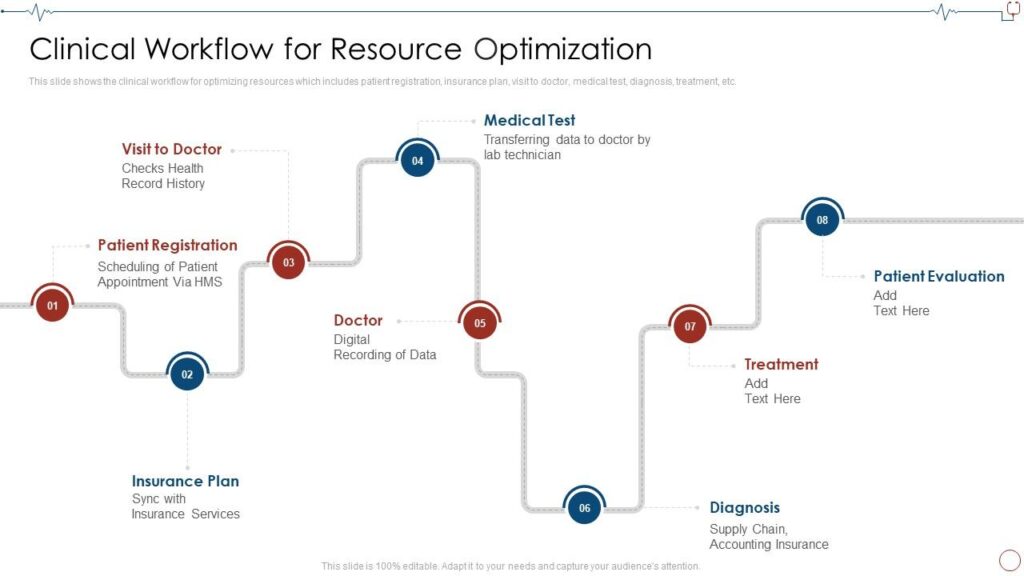clinical workflow optimization
Enhancing Efficiency, Accuracy, and Patient Care through Optimized Clinical Workflows
Optimize Clinical Workflows for Seamless Operations and Improved Patient Outcomes
Clinical workflow optimization involves streamlining processes in healthcare settings to improve efficiency, reduce delays, and enhance patient care. By integrating advanced technologies like AI, data analytics, and automation, healthcare providers can minimize redundancies, ensure accurate documentation, and prioritize patient needs. Optimized workflows enable better resource allocation, improved communication among care teams, and faster decision-making. This results in reduced operational costs, enhanced staff productivity, and a more seamless patient experience, ultimately driving better healthcare outcomes and satisfaction.
Process Automation
- Description: Automation focuses on replacing repetitive manual tasks with technology-driven solutions. This includes automating appointment scheduling, patient check-ins, billing, and medical documentation.
- Purpose: To save time, reduce errors, and allow healthcare professionals to focus more on patient care.
- Applications: Electronic Health Records (EHR) systems, AI-powered scheduling tools, and automated billing software.
Data-Driven Decision Support
- Description: This approach uses data analytics and AI to assist healthcare providers in making informed clinical decisions. It includes real-time alerts, predictive analytics, and personalized treatment recommendations.
- Purpose: To enhance the quality and speed of clinical decisions, improving patient outcomes and resource management.
- Applications: Clinical decision support systems (CDSS), AI diagnostic tools, and predictive modeling for patient risk assessment.
Key Approaches to Clinical Workflow Optimization
Streamlining Processes for Improved Efficiency and Patient Care
Clinical workflow optimization focuses on improving efficiency, reducing errors, and enhancing patient care by streamlining healthcare processes.
By leveraging technologies like automation and data analytics, healthcare providers can address operational bottlenecks and improve resource allocation. Process automation eliminates repetitive tasks such as appointment scheduling, patient check-ins, and billing, enabling staff to focus more on patient care. Tools like Electronic Health Records (EHR) and automated billing systems ensure smoother workflows and fewer administrative delays. Data-driven decision support is another critical aspect of optimization. Real-time analytics, predictive modeling, and clinical decision support systems (CDSS) empower healthcare teams to make faster, evidence-based decisions, improving treatment accuracy and patient outcomes. Optimized workflows foster better communication among care teams, reduce wait times, and enhance the overall patient experience. From hospitals to outpatient clinics, clinical workflow optimization is transforming healthcare delivery, ensuring that providers operate efficiently while prioritizing quality and patient satisfaction.

Outcomes of Clinical Workflow Optimization
"Enhanced Efficiency, Patient Satisfaction, and Improved Care Delivery"
Enhanced Efficiency and Reduced Bottlenecks
Clinical workflow optimization significantly improves operational efficiency by streamlining processes and eliminating redundancies. Automation of routine tasks such as scheduling, documentation, and billing allows healthcare professionals to dedicate more time to patient care. Optimized workflows reduce delays in procedures and minimize miscommunication among care teams, leading to faster decision-making and improved resource utilization. This enhanced efficiency not only improves staff productivity but also ensures that healthcare facilities operate smoothly, even in high-demand situations, delivering better outcomes overall.
Improved Patient Experience and Satisfaction
By optimizing clinical workflows, healthcare providers can offer a more seamless and patient-centric experience. Reduced wait times, streamlined appointment management, and faster diagnostic processes lead to higher levels of patient satisfaction. Additionally, data-driven decision support ensures accurate and personalized treatment plans, fostering trust and better communication between patients and providers. An improved experience encourages patients to engage actively in their healthcare journey, ultimately contributing to better health outcomes and long-term loyalty to the healthcare facility.
Take the First Step Towards AI Excellence – Reach Out Now!